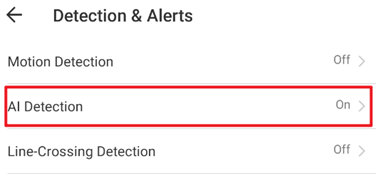How to reduce motion detections from rain, snow or insects,etc
Using the motion detection feature on an outdoor camera, you may receive many unwanted notifications and recordings from rain, snow, or insects. This is more likely to happen when the camera is in night vision mode with the IR light on.
Motion detection, as its name implies, will detect most movements from all kinds of objects, not just the human body.
How does motion detection work?
Before trying to reduce unwanted detections, we need to know how camera motion detection works.
The basic camera's detection mechanism is based on image changes between different frames. The frame is one of the many still images which compose the complete moving picture. If there is a difference between the frames, the camera will recognize it as a motion detected.
When it rains, the raindrops will cause a significant change in the image, therefore this kind of detection cannot be avoided.
Tips to reduce other detections:
1. Enable Person Detection
If your purpose is only to detect people, you may use the Person Detection in the camera settings and turn off the basic motion detection.
Person Detection is a feature that uses an algorithm to filter the detection and only reports when it detects a human body.
This way, only a moving human will trigger detection events.
To enable the person detection on Tapo Camera, you may go to Camera Settings->Detection & Alerts -> AI Detection


2. Adjust detection zone and sensitivity
Based on your use conditions, adjusting the detection zone and sensitivity may help reduce too many detections.
(1) The Detection Zone allows you to define a specific area that you want your camera to detect, everything outside of the zone will be ignored.
NOTE: Exclude the areas which have objects or small movements like trees, bushes, leaves waving in the wind; light changes like sunset or sunrise, car light of passing vehicles, tree shadow, reflections; public areas like busy streets, sidewalks, etc.
(2) Setting the detection sensitivity to a lower level can also help reduce the detections, but it may defeat the purpose of true motion detection. You may find that you’re missing alerts when there is a real person or animal in the camera’s view.
3. Adjust the angle and location of the camera
You may also adjust the installation angle to be away from the false alerts trigger. Try to avoid pointing the camera at busy public areas like busy streets, sidewalks, etc.
4. Use a camera that has a PIR sensor built-in.
A PIR is a Passive Infrared sensor that measures infrared light radiating from an object's field of view. Most legitimate movements will produce infrared light radiating especially person/animal movements to trigger the PIR detection while the rain, snow, insects, etc. will be ignored.
Tapo Battery Camera like Tapo C400/C420/C425 with a built-in PIR sensor can avoid most false detections.
Is this faq useful?
Your feedback helps improve this site.
TP-Link Community
Still need help? Search for answers, ask questions, and get help from TP-Link experts and other users around the world.


